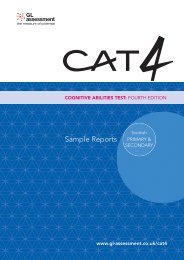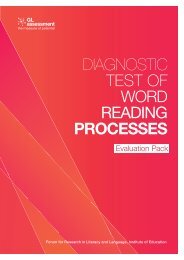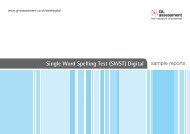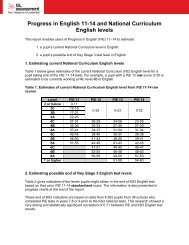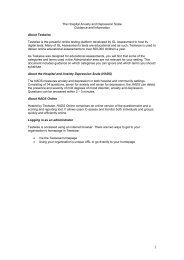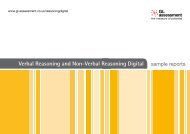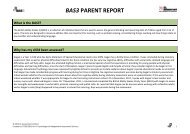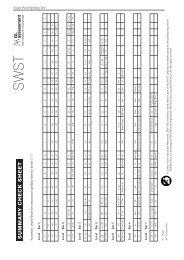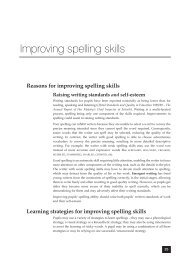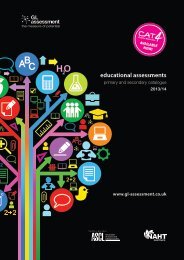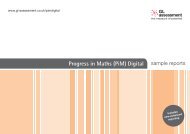educational assessments
quick guide - GL Assessment
quick guide - GL Assessment
- No tags were found...
Create successful ePaper yourself
Turn your PDF publications into a flip-book with our unique Google optimized e-Paper software.
REASONING<br />
NEW! Cognitive Abilities Test: Fourth Edition (CAT4)<br />
Why a fourth edition?<br />
While the premise of CAT has remained exactly the same, we have<br />
made some significant changes to the new edition based on the latest<br />
cognitive research and extensive customer feedback.<br />
A brand new suite of data rich reports<br />
One of the most exciting features of CAT4 is the development of a<br />
brand new suite of reports, offering richer and far more comprehensive<br />
assessment data. Users can now select from a range of eight new<br />
reports, including an enhanced Group report for teachers. The inclusion<br />
of more narrative in the 3 individual reports, makes them much easier to<br />
read and understand, supporting the interpretation of the data further.<br />
Designed with specific audiences in mind, the reports appear in a range<br />
of different formats from PowerPoint ® presentations for school<br />
leadership teams and governing bodies, to easy-to-understand reports<br />
for parents and pupils. These explain what the data means and how<br />
pupils can be supported in their learning, both at home and at school.<br />
A new structure with spatial ability at its heart<br />
As for the test itself, one of the main changes is an increased focus on<br />
spatial ability, with the introduction of a separate test. In CAT3, Nonverbal<br />
Reasoning and Spatial Ability were combined, however research<br />
has shown that by testing these abilities separately a more accurate<br />
assessment of a pupil’s potential is provided, allowing schools to report<br />
on these distinct abilities separately.<br />
The spatial test has been developed from research that has found pupils<br />
with high spatial ability may find it more difficult to learn during their<br />
school careers. This is because teaching, even in Science, Technology,<br />
Engineering and Mathematics (STEM) subjects, has a strong verbal bias<br />
and pupils cannot play to their strengths even in subjects where spatial<br />
ability is required.<br />
Identifying and recognising pupils with high spatial ability is not only<br />
important for individual pupils but also for the economy; a workforce<br />
educated to a high level in the STEM subjects is key to economic<br />
success.<br />
Example question from CAT4 – Level G<br />
Up-to-date normative data<br />
To ensure rigour, CAT4 was standardised on 25,000 Primary and<br />
Secondary School pupils in Autumn 2011. This extensive<br />
standardisation process means that teachers can be assured that CAT4<br />
provides them with accurate data about their pupils’ potential based on<br />
the performance of today’s pupils across the UK.<br />
Other improvements in CAT4<br />
In addition to the developments outlined above, the fourth edition of<br />
CAT gave the opportunity to incorporate a number of improvements<br />
which are listed below.<br />
• The overall time for CAT4 is shorter than that for CAT3, despite the<br />
inclusion of the new Spatial Ability test. This has been achieved by<br />
reducing the number of tests in each part from three to two.<br />
• A new Level G has been developed. This is set at an ‘above average’<br />
ability to reflect the bias in usage of CAT4 in Years 11/S5 and 12/S6<br />
and Year 13 for Northern Ireland.<br />
• By carefully developing question and answer options, the items in<br />
Verbal Reasoning are more up-to-date and culturally universal.<br />
• The extent to which scoring on the Verbal and Quantitative Reasoning<br />
tests depends on past education has been reduced. This has been<br />
achieved by removing Sentence Completion and Equation Building,<br />
which necessitated reading comprehension skills and knowledge of<br />
mathematical conventions respectively.<br />
• Levels of the tests are now less tightly linked to the adjacent ages, to<br />
enable each level to be more accurately pitched at the midpoint of<br />
each age group’s ability range.<br />
Example question from CAT4 – Level D<br />
CAT4 WEBSITE<br />
Visit www.cat4support.com for additional information about CAT4,<br />
frequently asked questions, sample reports and videos/<br />
demonstrations of the assessment.<br />
Find your Area Consultant on pages 4–5 Tel: 0845 602 1937 www.gl-assessment.co.uk<br />
11



